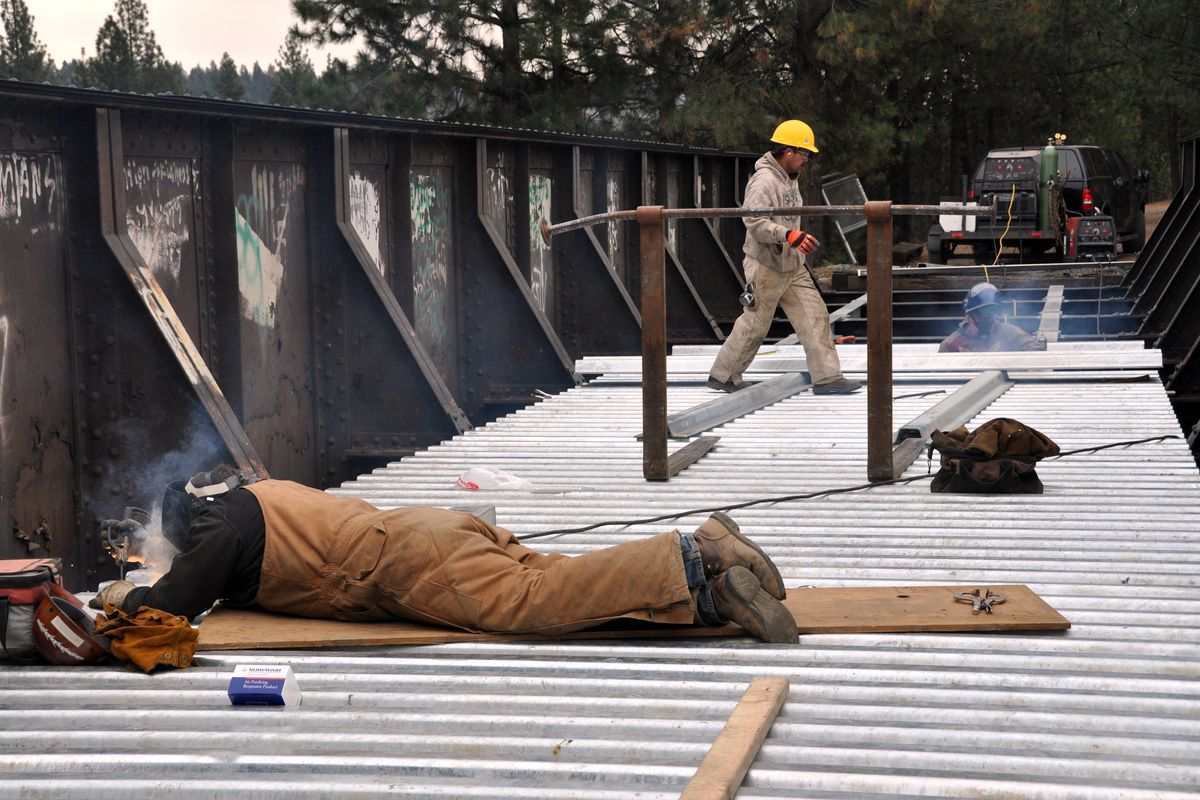Paving nearly complete on Fish Lake Trail

Spokane is on the verge of having a spiffy, newly paved stretch of rail trail that eventually will run all the way to Cheney.
Contractors this month are putting the finishing touches on 4.4 miles of the Fish Lake Trail. The route follows an abandoned railway starting from a main trailhead near the intersection of Government Way and Sunset Boulevard.
“When I first started working on this I thought it was a waste, but I couldn’t believe how many people we’ve seen using the trail even before it’s finished,” said Emery Little, field foreman for Wesslen Construction.
Depending on weather and the availability of back-ordered materials, construction should be wrapped up in early November, city officials said.
The city of Spokane has owned the rail bed for years, and walkers and mountain bikers have been using the rough path and bridges, which had no safety railings.
A state grant of $987,500 had been approved last year and planning was underway, but federal stimulus funding secured this spring paved the way for workers to begin developing the trail, said John Miller, the city’s lead project engineer.
In March, with plans on paper and the project “shovel ready,” the city secured $778,317 in American Recovery and Reinvestment Act funds to combine with the state grant.
Up to $90,000 in city pathways funds may be needed to finish the project, Miller said.
Little said about 40 workers have been involved since construction began on July 8.
When all the pieces are linked, the trail would be a non-motorized paved thoroughfare running about 14 miles to Cheney. There the route becomes the Columbia Plateau Trail, managed by Washington State Parks, extending another 19 miles through Turnbull National Wildlife Refuge on a crushed-rock surface that’s sweet to ride on a fat-tired bicycle.
Cheney has developed and paved 3.75 miles of the abandoned railway from its city limits toward Spokane, ending at Fish Lake.
Spokane’s current 4.4-mile project will connect with about 3 miles of the route that previously had been pave.
However, completion of this Phase 2 in the trail’s development will still leave a two-mile gap in the middle of the Fish Lake Trail near Marshall.
“The challenge of dealing with the live railroad crossing will be left for Phase 3,” said Katherine Miller, the Public Works official who oversees Spokane’s transportation program. “The trail will be blocked off at that point and signage will educate riders about safety issues.
“Completing this 4.4 miles of safe, useable trail will help get support for private funding to finish the trail,” she said.
“I think the railroad officials would like us all to just go away, but we’re not going to do that,” said Dan Schaffer, a Fish Lake Trail advocate who’s coordinated much of the volunteer work to maintain the route in recent years. … We have just one missing link and whether we put railroad crossing signals or a tunnel under the railway, we have good options to finish this trail.”
After Phase 2 is completed this fall, bicyclists continuing the entire length of the Fish Lake Trail from Spokane will still have to cross the railroad at Scribner Road to reach Cheney-Spokane Road. Then they will have to pedal nearly two miles on Cheney-Spokane Road before picking up the trail again to ride from Fish Lake to Cheney.
“But we’ll still have about 8 miles of paved trail heading out of Spokane for people to enjoy,” said Rich Proszek, another city engineer coordinating the project.
Last week, works finished paving the 4.4 miles of trail except for the Interstate 90 bridges where work continues. This week, workers will focus on landscaping at the trailhead and finishing the decking and safety railings on bridges. Some paving remains to be done near the trailhead and a restroom and bike racks have not yet been installed.
“We were planning to hold a ribbon cutting of some sort when the work is done, but we’re a little behind schedule and there might be snow on the trail by then,” Proszek said.
“Of course that’s fine if you’re a cross-country skier.”